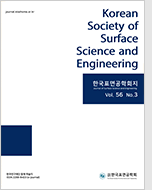
- Past Issues
- e-Submission
-

2021 Impact Factor 1.766
5-Year Impact Factor 1.674
Editorial Office
- +82-2-563-0935
- +82-2-558-2230
- submission@kssse.or.kr
- https://www.kssse.or.kr/

2021 Impact Factor 1.766
5-Year Impact Factor 1.674
The Korean Society of Surface Science and Engineering 2023;56(5):289-298. Published online: Oct, 31, 2023
DOI : 10.5695/JSSE.2023.56.5.289
In this study, the effect of drying temperature on characteristics of the trivalent chromate film on electroplated zinc was investigated. An zinc-electroplated iron specimen with a thickness of 5 μm was used for chromate treatment. Chromate treatment was conducted in a solution diluted 10 times from a mixture of Cr(NO3)3∙9H20 360 g/L, Co(NO3)2∙6H2O 60 g/L, Na2SO4 60 g/L, NH4F∙HF 25 g/L, and NaOH 20 g/L. The zinc electroplated specimen was treated using the chromate solution with pH 2.0 at 25 ℃ for 60 s. Subsequently, chromate-treated samples were dried in an electric furnace for 2h with temperature varied from 25 to 125 ℃. The corrosion rate increased with the increase in the drying temperature, and the surface morphology of the chromate-treated film was observed using FE-SEM. When the drying temperature changed, the color of the chromate film changed from green to yellow, and the thickness of the film changed from 362 to 241 nm, respectively. Additionally, corrosion resistance was evaluated via a salt spray test.
Keywords Zinc Electroplating; Chromate; Corrosion Resistance; Drying Tempareture; Film Color; Film Thickness